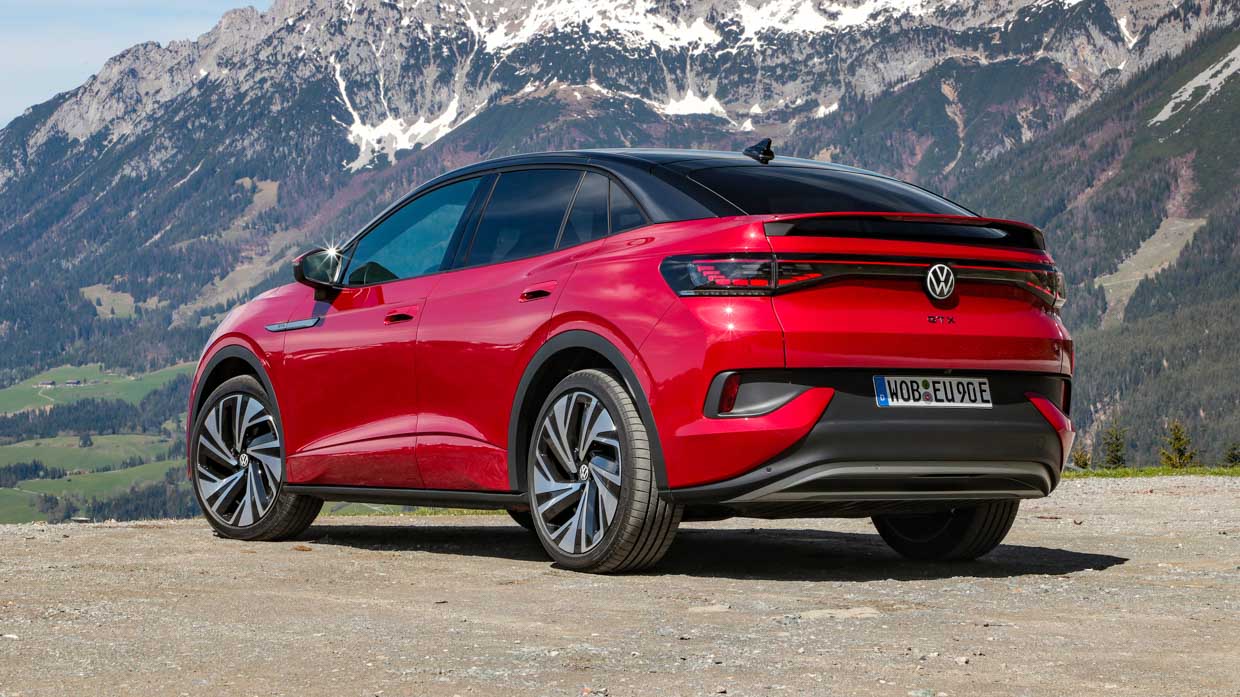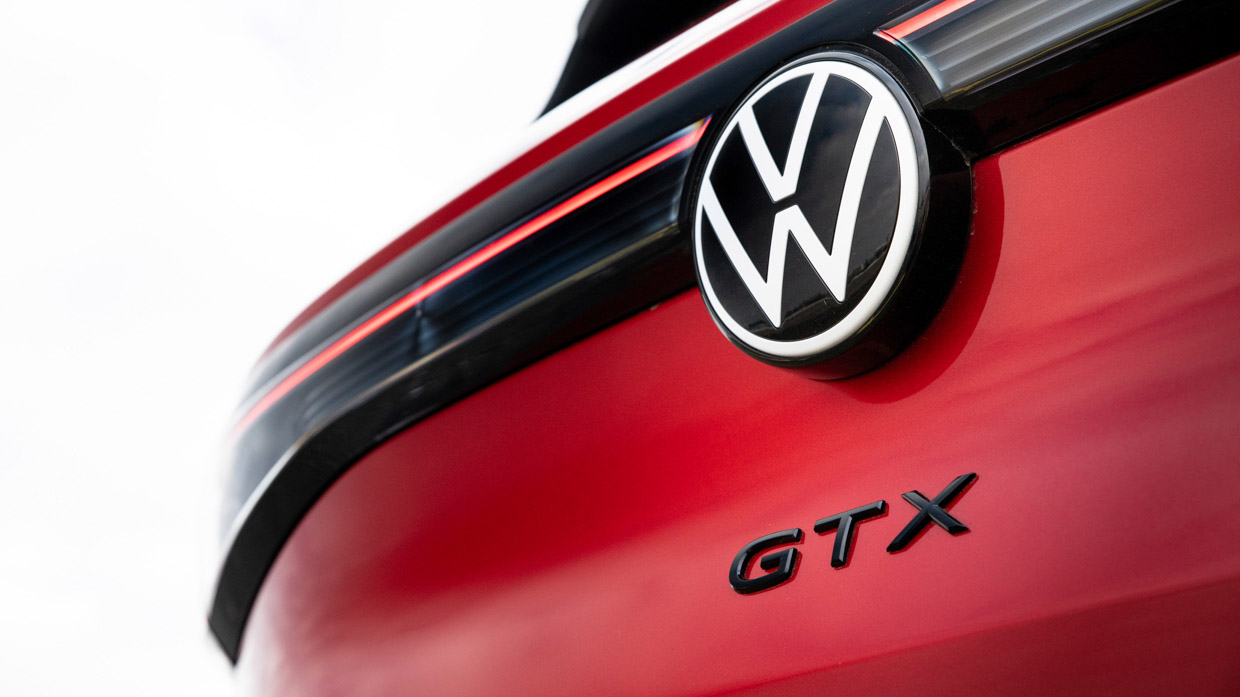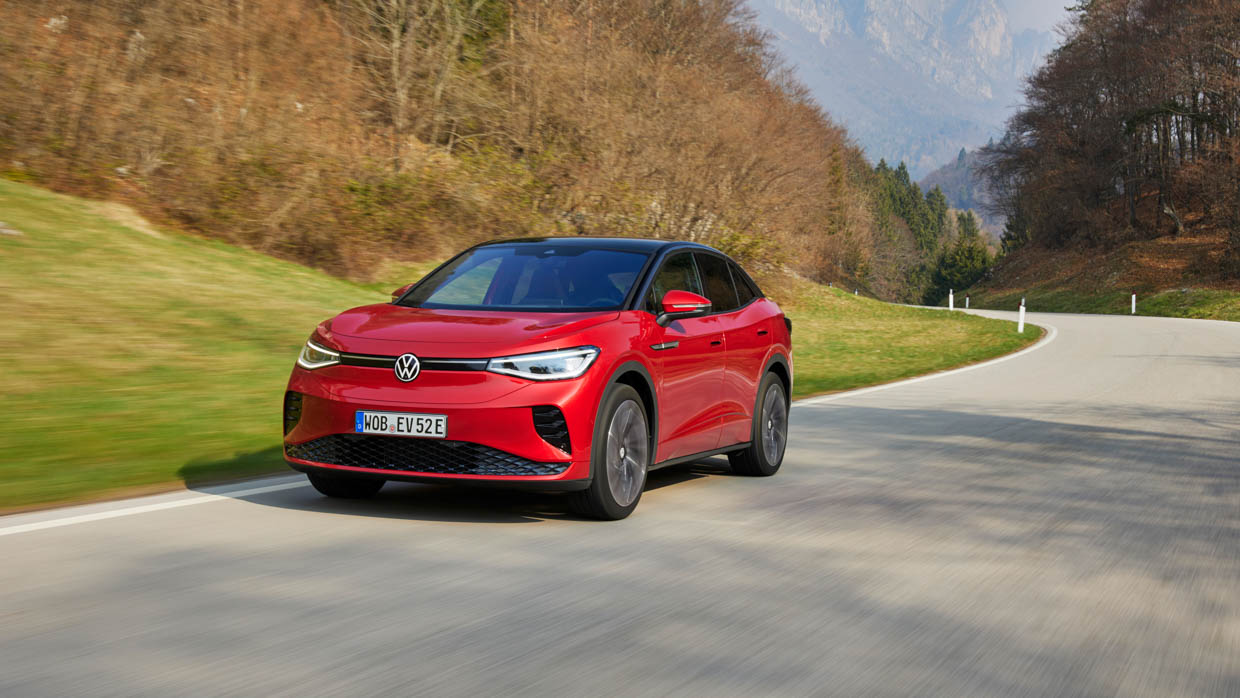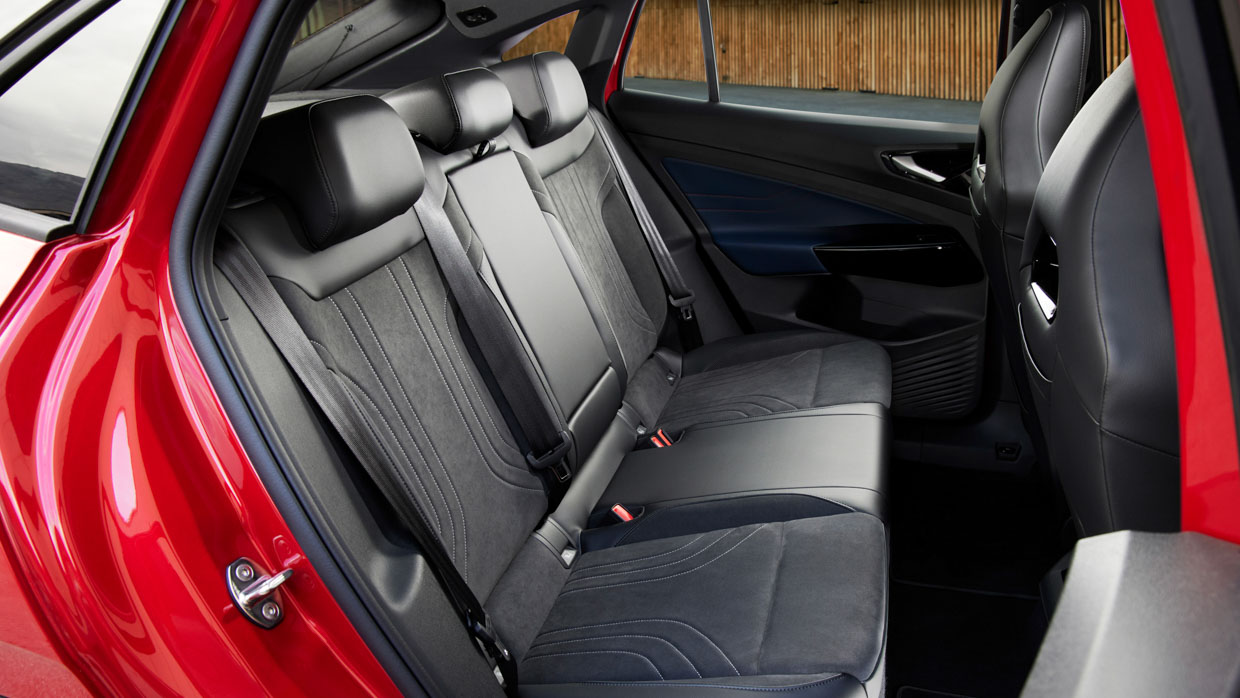-
Car Reviews
- All reviews
- Midsize SUVs
- Small cars
- Utes
- Small SUVs
- Large SUVs
- Large cars
- Sports SUVs
- Sports cars
- Vans
Latest reviews
- Car News
-
Car Comparisons
Latest comparisons
- Chasing Deals
VW says its ID4 and ID5 electric SUVs have what it takes to compete with the best-selling Tesla Model Y. We take an early drive in the GTX flavour of the coupe-style ID5
The top-selling electric vehicle in Australia is the Tesla Model Y: in the first nine months of 2023, 23,457 Aussies took one home.
There are strong reasons why — the Tesla deftly balances price, capability and efficiency; the Model Y also projects an air of being slightly elevated above the fray of regular cars without being an unaffordable luxury. That’s typical Volkswagen territory, you might think.

Well, yes—and it is for that reason that Volkswagen’s Australian management openly name-checks Tesla’s SUV when asked about the target for VW’s dual-prong attack in this segment.
By mid-2024, the Volkswagen ID4 midsize electric SUV and its ‘coupe’-bodied ID5 sibling will roll into the brand’s Australian dealers in plentiful number.
Volkswagen executives don’t shy from conceding that the brand is late to EVs in Australia, but that it is sharpening an onslaught of likeable, competent electric cars in various shape, size and price.

The ID4 and ID5 will lead the charge but they will be quickly followed by the ID Buzz (a Kombi-revival van) and the ID3 hatch.
Later this decade, Volkswagen will turn its hand to second-gen EVs that will include the ID GTI hot hatch, at least one small SUV, and possibly the ID7 sedan and wagon. Eventually, the brand will go all-electric.
Naturally, there is some pressure on the ID4 and ID5 to set the tone and establish positive first impressions among Australia’s Volkswagen faithful.

So, are they any good? We took part in an extensive preview drive nine months ahead of the pair’s arrival in Australia to see what they were like behind the wheel.
The setting may have been the highways and byways of southern Germany and Austria, but we encountered plenty of settings that reminded of home – constant 100km/h, crawling in traffic snarls, as well as scenic country touring.
Even though Volkswagen will be bringing rear-wheel drive (RWD) and all-wheel drive (AWD) GTX versions of both the ID4 and ID5 to Australia, only the latter was available for our sampling: a pair of ID5 GTX coupe-SUVs sporting a 220kW dual-electric motors, 77kWh-usable batteries and Kings Red paintwork.

But in a testament to the pace at which Volkswagen (and other carmakers) are iterating their EVs, even this spec is outdated now – in the same week we drove the ID5 GTX, VW head office was rolling the 2024 version out of the Zwickau, Germany factory with an upgraded 250kW motor among other alterations.
The Australian-specification ID4 GTX and ID5 GTX will indeed be the 250kW model, while the more affordable RWD models will get VW’s latest 210kW electric motor which builds on the efficiency of the outgoing 170kW powertrain.
Much of this will carry over — but the new one’ll be faster and more efficient, addressing two areas we’d noted for criticism. Acceleration from 0-100km/h is slashed from 6.3 seconds to 5.4.
Although not incredibly relevant in Australia, the top speed is still capped at 180km/h.

With the 77kWh battery remaining, a eight percent efficiency bump to 14.4kWh/100km sees range hit a claimed driving range of 533 kilometres.
Volkswagen’s target is the Tesla Model Y Long Range variant, which costs $78,400 before on-road costs at the time of writing in October 2023.
Interestingly, both the ID5 GTX and the Model Y Long Range share a 533km (WLTP) range claim, though the Tesla—which has a smaller 75kWh usable battery—has very slightly better efficiency.
The Tesla is not the only competitor the ID5 has to worry about either, with electric vehicles such as the Hyundai Ioniq 5 and Kia EV6 also solid options in this space.

Barring any major economic change, expect to see the RWD ID4/ID5 kicking off in the $75,000-$80,000 range, with perhaps a $5000 addition for the AWD GTX.
The similarities aren’t just related to price. The Tesla and both Volkswagens are styled quite radically for SUVs, erring clearly toward aerodynamic efficiency. A clean and crisp Tiguan Mk II the ID5 is not; this isn’t an ugly crossover, but the soft lines don’t hit the handsome highs of recent combustion Volkswagen efforts to our eyes.
Just as with Franz von Holzenhausen’s Model Y, though, the disciplined aero styling dramatically cuts the drag coefficient of the Volkswagen SUVs (especially the ID5 with its sloping roofline), and our tested range of 468km in mixed driving is reasonably useful—and this range will improve next year.

Step inside the ID5 GTX, though, and any notion that this SUV shares a core philosophy with the Tesla Model Y comes to a clanging halt. The Volkswagen has a cleanly-penned cabin, but it is far from hyper-minimalist.
The driver gets a screen, there are fixed shortcut keys to many controls, there are wiper and indicator stalks…
There is also an overuse of touch-sensitive capacitive buttons, at least in the 2023-spec ID5 we tested. Volkswagen is making its way through the range, reverting finnicky climate sliders and steering wheel shortcuts to physical buttons. The SUVs haven’t been done yet but it’s possible that Aussie cars will arrive with tactile switches.

We know that Australian ID4s and ID5s will pack Volkswagen’s new ‘version 4.0’ infotainment—a user-focussed redesign of the 13.0-inch touchscreen layout.
A level of app-driven connectivity will be standard in Australia but the need for a custom solution means this probably won’t be quite as extensive as in Europe (or in a Model Y).
Software foibles afflicted the launch of Volkswagen’s EVs in Europe; various processor alterations fixed complaints of lag some time ago.

And, baseline frrustration with soon-to-be-replaced touch controls aside, we didn’t struggle with the ID5’s tech, with delivered snappy screen responses and solid wireless Apple CarPlay connections.
And we openly admit that we still prefer Volkswagen’s provision of a small digital driver display showing basics like speed, efficiency, range and the next nav direction over the Tesla cabin model, which places all such info in the central-mounted screen partly to save on production costs.
The remainder of the ID5’s cabin is mostly familiar to anybody who has driven a late-model Volkswagen, though the volume of space on offer will surprise and delight some. There’s no transmission, so the centre of the car is liberated with extra storage and foot space.

The lack of a true centre console means the front seats are like captain’s chairs, with adjustable fold down armrests. The pews are comfortable and supportive; our Euro-spec test cars amusingly sported cloth-upholstered, manually-adjustable seats. Safe to assume Australia will have heated and powered units instead.
If there’s a shortfall in here, it’s not the tech; it’s the relatively austere interior finishes that aren’t up to the level of an $80K car, with swathes of hard plastic on the dash and doors. The second-gen Tiguan seemed a bit mean in the materials department when it was released in 2016; the ID5 is at least as frosty.
But there is light on the horizon; as we noted in our 2024 ID3 hatch review, Volkswagen is upgrading the quality of its EV cabins with extra soft-touch materials that make a real impact. The ID4 and ID5 haven’t been plush-ified yet, but it’s coming.

If you are a Tiguan owner already, you’ll be impressed by the rear seats in the ID4 or ID5: legroom is excellent, thanks to the long wheelbase, and it’s far more possible to get a third person into the centre seat in the EVs than in the petrol SUV thanks to heaps of extra—and flat—floor space. Rear air vents also feature.
Not even the wagon-bodied ID4 is available with a third row, so both SUVs are strictly five-seaters.
One upshot is plenty of storage space. Behind a power tailgate, our ID5 GTXs offered up 549 litres of room; the ID4 is four litres smaller but has additional vertical boot space. No spare wheel of any kind is fitted, limiting touring confidence.

Out on the road, the ID5 GTX is the anti-Model Y. Honestly, that’s not hyperbole: the two electric SUVs are completely different in their approach to driving dynamics and we suspect that the camps that prefer one to the other will hold that opinion stridently.
As for us, we try our best to be objective, and can see various benefits to the approaches of both carmakers. For instance—the ID5 GTX lacks a user-selectable strong regenerative braking setting that it really should have in 2023. In the ‘burbs, heavy regen is a great way to reduce driving effort while boosting efficiency.
But many people don’t want strong regen on country roads, which is why it’s nice to have different settings available to the driver—you can’t turn off or seriously limit regeneration in the Tesla. The ID5 allows zero, mild or medium regen; just not true one-pedal driving.

As a result, there is lost opportunity for daily commute driving, but on backroads and highways the ID5 is pleasant and familiar to pilot, with reassuring responses through the accelerator, adjustable regen, brake pedal and steering wheel. It’s a little bigger and heavier than a Tiguan but overall, you know you’re in a Volkswagen crossover…
…albeit on that is based on a rear-wheel drive platform. Unlike a Tiguan’s front-engine, front-wheel drive (FWD) based chassis, all of Volkswagen’s current ID-family vehicles are built around a dominant rear motor.
If you option AWD (standard in the GTX) the front motor is much more modest, so the RWD feel is noticeable.

By the way, GTX means precisely that: a Volkswagen EV with AWD and a higher level of performance. Usually, hot AWD cars from VW wear R badges, and indeed, electric Rs are coming—as are electric GTIs, which will retain their classic FWD layout. The first will be the 2027/2028 ID GTI.
But we digress. We were fortunate to get seat time in the ID5 GTX on the ascent up Austria’s formidable Großglockner pass, which threads scores of corners together on an at-times hair-raising climb to the road’s 2504m peak. By and large, we enjoyed what we found.
Natural steering combines with predictable body control to make the ID5 GTX more pleasurable to drive sportily than any Model Y. Without doubt, the Teslas are faster (considerably so for the Model Y Performance) but their ultra-flat composure limits driver engagement while promoting understeer.

We’d wager we corner faster in the Volkswagen, which feeds ample communication to the driver about available tyre grip; this SUV does allow a limited amount of body roll, and you can use this momentum to shift the vehicle’s weight. Selecting ESC Sport allows some oversteer out of corners, even with 2023’s less powerful motor.
We think few buyers will really push this SUV’s handling limits, but we think most Australians who try an ID4 or ID5 will find themselves more at ease with pushing harder on a country road, where they will find reassuringly sorted and adjustable dynamics.
Our testers rolled on huge 21-inch wheels—likely the size we’ll get in Australia; like so many EVs, unsprung mass is much greater than on a similar combustion car simply by dint of the enormous wheels and tyres required to support the overall mass.

Yet the ID5 GTX didn’t coarsely bang into holes; in fact, overall compliance was very decent. The ride quality is aided by 15-stage adaptive dampers.
The dampers do need an extra polish; in most of their settings, some fizz and fidget was being induced into the cabin. Fortunately, the very softest setting eliminated these effects, though choosing a slightly firmer ride shouldn’t be accompanied by unnecessary road patter.
That odd effect aside, refinement is a strong suit of the ID5 GTX, which mostly presents a serene and quiet environment in which to enjoy the available Harman-Kardon premium stereo. A real advantage of electric cars in general.
Well-behaved, too, are the semi-autonomous safety systems; the lane-centring is strong but well-tuned (and able to be switched off through the touchscreen), while the adaptive cruise control is reliable for relieving fatigue for longer stints. The two features work together in Travel Assist mode.

Other notable safety features include rear cross-traffic alert, front and rear parking sensors, along with basics such as forwards autonomous emergency braking with pedestrian and cyclist detection.
So, there’s much to like about the ID5 GTX, and, we assume, the RWD models too. While Volkswagen is admittedly late to this segment, it is also heartening that Australians will be receiving examples of the ID4 and ID5 with at least one major upgrade and several minor upgrades compared to when the cars launched in Europe.
The next step will be assessing the cars on Australia’s demanding local roads. That will be a task for winter 2024—and closer to then, we’ll also know precisely how much these cars will cost and what they will include, feature-wise.
About Chasing cars
Chasing Cars reviews are 100% independent.
Because we are powered by Budget Direct Insurance, we don’t receive advertising or sales revenue from car manufacturers.
We’re truly independent – giving you Australia’s best car reviews.
The estimate provided does not take into account your personal circumstances but is intended to give a general indication of the cost of insurance, in order to obtain a complete quote, please visit www.budgetdirect.com.au. Estimate includes 15%^ online discount.
^Conditions Apply
Budget Direct Insurance arranged by Auto & General Services Pty Ltd ACN 003 617 909(AGS) AFSL 241 411, for and on behalf of the insurer, Auto & General Insurance Company Limited(ABN 42 111 586 353, AFSL 285 571).Because we don’t know your financial needs, we can’t advise you if this insurance will suit you. You should consider your needs and the Product Disclosure Statement before making a decision to buy insurance. Terms and conditions apply.
Indicative quote based on assumptions including postcode , 40 year old male with no offences, licence suspensions or claims in the last 5 years, a NCD Rating 1 and no younger drivers listed. White car, driven up to 10,000kms a year, unfinanced, with no modifications, factory options and/or non-standard accessories, private use only and garaged at night.
^Online Discounts Terms & Conditions
1. Discounts apply to the premium paid for a new Budget Direct Gold Comprehensive Car Insurance, Third Party Property Only or Third Party Property, Fire & Theft Insurance policy initiated online on or after 29 March 2017. Discounts do not apply to optional Roadside Assistance.
2. Discounts do not apply to any renewal offer of insurance.
3. Discounts only apply to the insurance portion of the premium. Discounts are applied before government charges, taxes, levies and fees, including instalment processing fees (as applicable). The full extent of discounts may therefore be impacted.
4. We reserve the right to change the offer without notice.